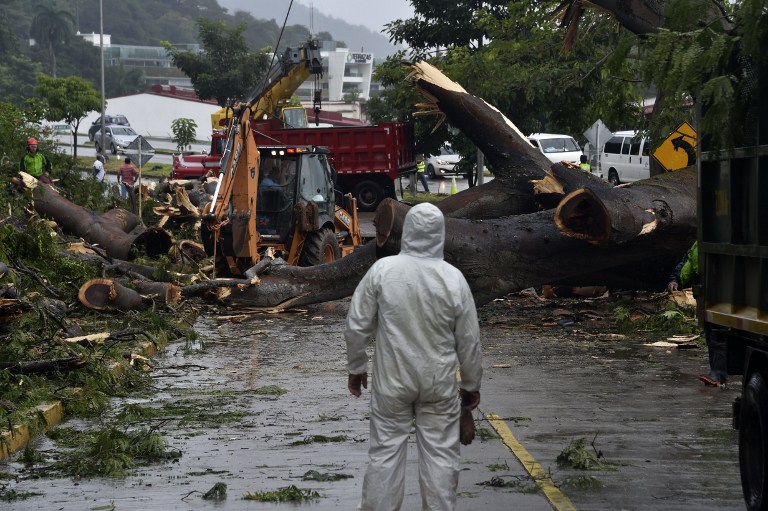
Tropical Storm Otto, that is expected to become a full-on hurricane in the Caribbean, was lurching toward Central America on Tuesday, with its rainy fringe already causing three deaths in Panama and prompting coastal evacuations in Costa Rica. In Panama, three people died from a mudslide and a falling tree provoked by the first outer dump of Otto’s heavy rains, the head of the National Civil Protection Service, Jose Donderis, told AFP.
/ AFP PHOTO / Rodrigo ARANGUA
SAN JOSE, Costa Rica (AFP) – by Marc BURLEIGH
A Caribbean storm verging on a hurricane spun towards the coasts of Costa Rica and Nicaragua on Wednesday, prompting evacuations and red alerts ahead of “life-threatening” flash flooding.
Tropical Storm Otto was forecast to strengthen into a hurricane with winds over 119 kilometers (74 miles) per hour when it makes landfall on Thursday, the US National Hurricane Center said.
On Tuesday, though the storm proper was at sea, its exterior band dumped heavy rain on Panama, killing two people in a mud slide and crushing a nine-year-old boy in a car in the capital, according to a senior emergency services official.
A search was underway on Wednesday for three people who went missing in a small boat, Jose Laniado, operations chief for Panama’s National Air and Naval Service, told media. Another person was feared swept away by a river.
In Costa Rica, officials ordered the evacuation of more than 4,000 people along the sparsely inhabited northern half of its Caribbean coast.
The Teletica television network reported that two people were arrested for prowling through evacuated homes.
“Some people don’t want to leave their homes, leave all their possessions, their animals,” police officer Christian Rodriguez told the Costa Rican newspaper La Nacion in the village of Batan, close to the Caribbean port city of Limon.
Danger to crops
Nicaraguan authorities issued a red alert for the southern part of the country and prepared evacuations as well. Its coastal town of Bluefields, population 46,000, was expected to feel the brunt of the storm.
The high winds and heavy rains could devastate crops — a big blow especially in Nicaragua, one of the poorest countries in Latin America.
Otto “could seriously jeopardize food security for small-holder farmers who rely on maize, beans, cocoa, honey, coffee and livestock for their livelihoods” in Nicaragua, Jennifer Zapata, a regional director for Heifer International, a US-based poverty-fighting charity, said in a statement.
“The storm is coming at a terrible time for the vital coffee crop, which is usually harvested between now and December,” she said.
Otto was a rare, late-appearing weather system in the Atlantic storm season, which runs from June to the end of November.
It was also on an unusually southern trajectory. If it does strengthen, it will be the first time Costa Rica has suffered a direct hit from a hurricane since records began in 1951.
A previous, far-stronger hurricane, Matthew, devastated parts of southern Haiti early last month, killing 546 people and leaving nearly 175,000 homeless.
Mud slides likely
The US National Hurricane Center said up to 50 centimeters (20 inches) of rain could fall on northern Costa Rica and southern Nicaragua between Wednesday and Thursday.
“These rains will likely result in life-threatening flash floods and mud slides,” it warned.
Dangerous surf and rips were also likely, it said.
Embassies in the region urged their nationals to heed official warnings over the storm, which was striking weeks before the peak tourist season in December.
The US embassy in San Jose advised its citizens to avoid the most at-risk areas and to “exercise caution wherever they are in Costa Rica, as the hurricane may affect the entire country for several days as road, visibility and river conditions may worsen.”







